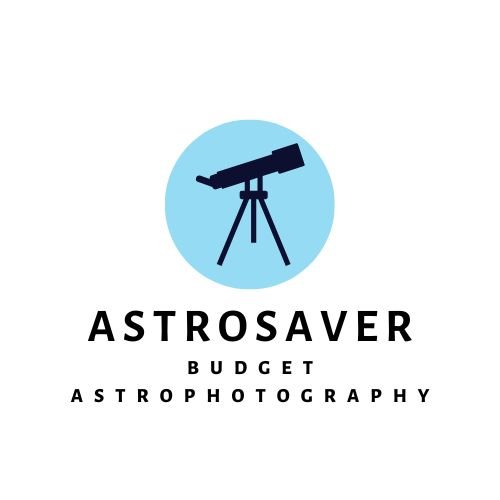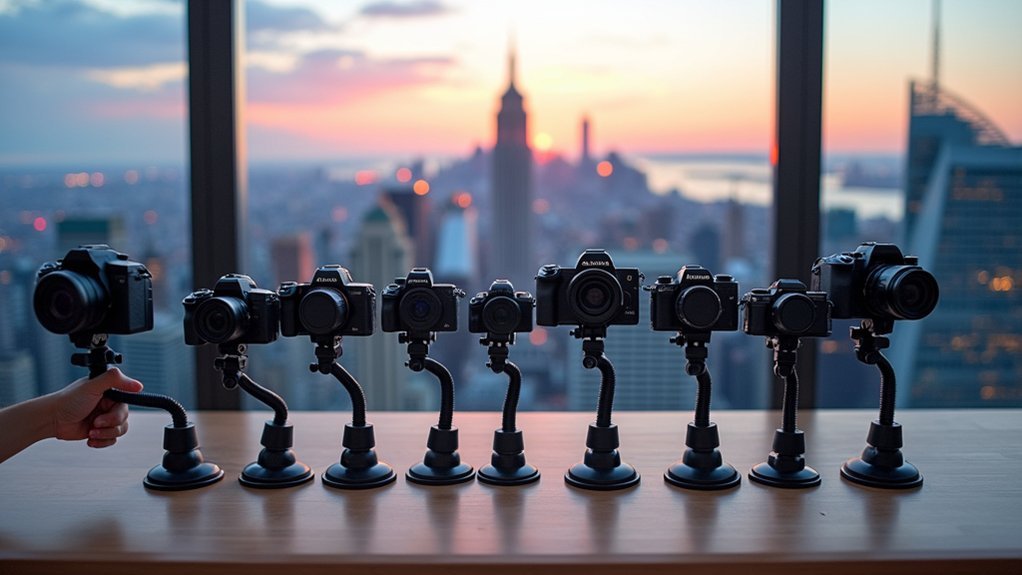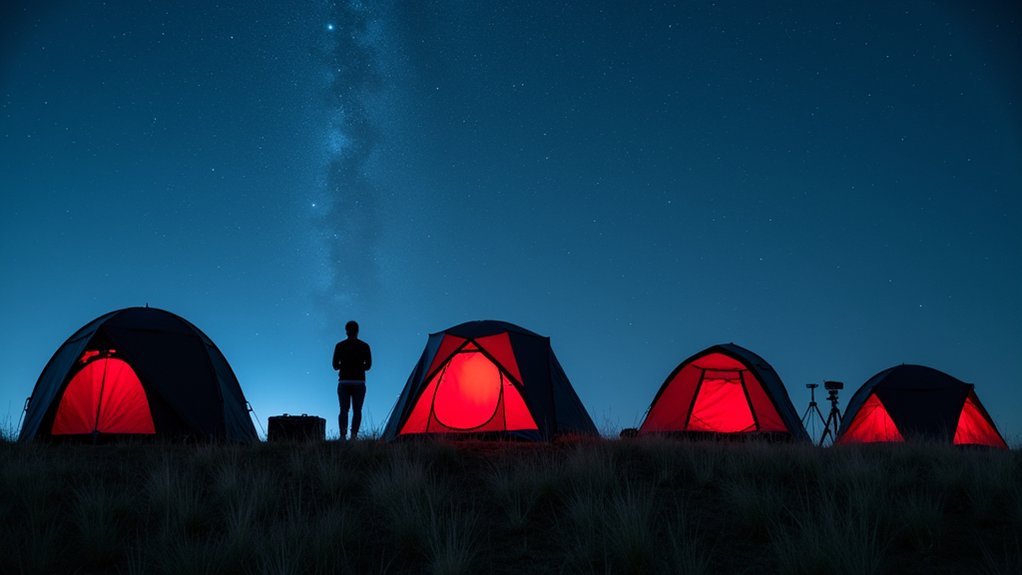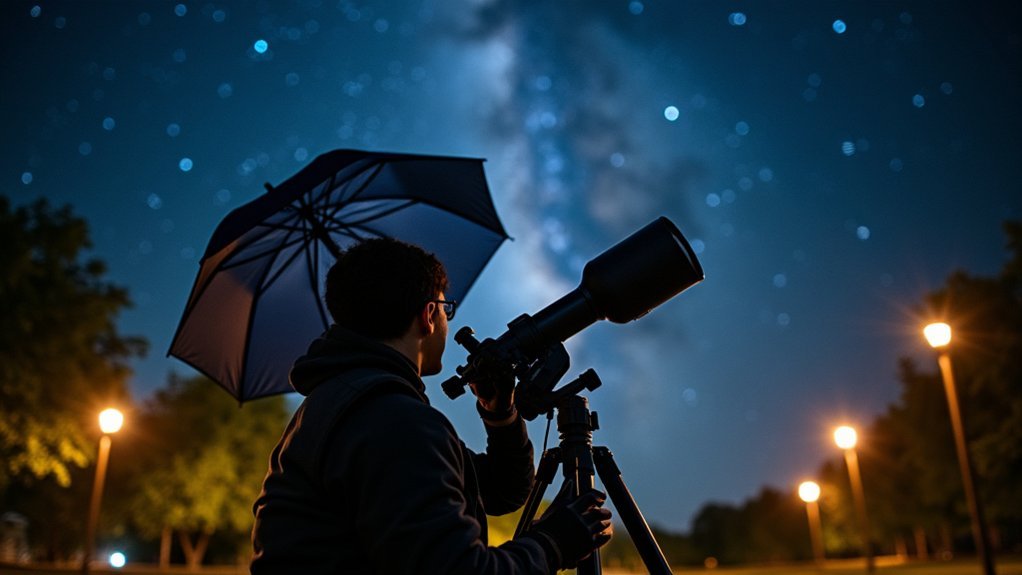A Bahtinov mask is your secret weapon for perfect astrophotography focus. You’ll need thin, non-transparent plastic, a knife, scissors, and a printed template matching your telescope’s aperture diameter. Cut the pattern carefully, secure it over your telescope, and aim at a bright star. Adjust focus until the central diffraction spike sits perfectly between the outer spikes. This simple DIY tool, costing under $20, will transform your blurry stars into pinpoint precision jewels.
What Is a Bahtinov Mask and Why You Need One

Precision is the holy grail of astrophotography, and the Bahtinov mask is your secret weapon for achieving it.
Invented by Pavel Bahtinov, this ingenious focusing tool creates a distinctive diffraction pattern when pointed at a bright star, giving you visual feedback that’s far more intuitive than numerical values.
When you use a Bahtinov mask, it produces three diffraction spikes forming a Ж-like pattern. Perfect focus is achieved when the central spike is exactly symmetrical between the outer spikes. Your brain processes this visual alignment much more effectively than traditional focusing methods.
The beauty of the Bahtinov mask lies in its versatility—it works with virtually any telescope size and can be easily made at home using printable templates customized to your specific aperture.
Materials Needed for Your DIY Bahtinov Mask
Before diving into construction, you’ll need to gather a specific set of materials to create an effective Bahtinov mask. The foundation of quality Bahtinov masks is a hard, thin, non-transparent plastic binder that blocks light effectively while maintaining durability.
For precision cutting and assembly, you’ll need:
- A sharp Stanley or hobby knife and scissors
- A ruler and marker pen for accurate measurements and outlines
- A printer (preferably A3 size) for templates, especially for larger telescopes
- Strong contact glue and plastic strips for creating a mounting ring
If you’re making an 8-inch mask, consider adding thick paper or fine cardboard behind your plastic to increase stability.
These materials guarantee your mask will attach securely to your telescope’s aperture while maintaining proper alignment.
Finding the Right Template for Your Telescope

Why does template selection matter so much for your Bahtinov mask? A properly sized template guarantees your focusing mask produces the sharp diffraction spikes needed for precise focus during astrophotography.
Start by measuring the exterior diameter of your telescope’s aperture. This vital measurement determines the overall size of your Bahtinov focusing mask. Online resources like Astrojargon allow you to generate custom templates tailored to your specific telescope specifications.
When printing your template, use Adobe PDF reader to maintain accurate sizing. For larger apertures, consider mosaic printing with a 1-inch overlap between sections.
Don’t forget to account for your telescope’s focal ratio—different f-numbers require slightly different mask designs. This is especially important if you’re using Barlows or focal reducers, as they alter your optical system’s effective focal length.
Step-by-Step Mask Construction Guide
Gather your materials before diving into the construction process. Once you have your printed Bahtinov template that matches your telescope’s aperture, cut your hard plastic or thick paper using a metal ruler and hobby knife. Make precise cuts along the marked slots to guarantee the mask functions properly.
Prep all materials first—proper templates and sharp tools ensure precision cuts essential for a functional Bahtinov mask.
Secure the template to the cut plastic with contact glue or masking tape, checking that all edges are firmly attached. For mounting, measure your telescope’s outer diameter and create a supporting ring from plastic strips.
- Cut all slots precisely—uneven cuts will affect diffraction pattern quality
- Use strong adhesive to prevent separation during use
- Leave no loose edges that could catch wind
Test the completed Bahtinov mask on a bright star to verify proper functioning.
Mounting Options for Different Telescope Types

With your Bahtinov mask constructed, you’ll need to determine the best way to attach it to your specific telescope. The mounting options vary depending on your telescope type, but they all require a secure fit over the aperture.
For refractors, a simple front mount works best, while reflectors may need a custom adapter to properly position the mask. If you’re using a Newtonian, place the mask on the tube’s front, ensuring proper alignment with the optical axis.
Many telescopes accommodate screw or clip systems to hold your mask firmly in place during focusing sessions. For versatility across different instruments, consider flexible mounting options like elastic bands or Velcro straps. These allow quick attachment and removal without modifying your telescope.
Always verify the mask fits the exterior diameter of your telescope for peak performance.
How to Use Your Bahtinov Mask Effectively
Once you’ve constructed and mounted your Bahtinov mask, achieving perfect focus becomes remarkably straightforward. Place the mask securely over your telescope’s aperture, ensuring a snug fit to prevent light leaks.
Next, aim your telescope at a bright star like Arcturus. Through your eyepiece or camera display, you’ll see distinctive diffraction spikes created by the Bahtinov mask.
Adjust your focus knob until:
- The central spike is perfectly centered between the outer spikes
- All diffraction patterns appear symmetrical and sharp
- Spikes are clearly defined without blurriness
- Pattern maintains stability when you stop adjusting
Remove the mask and verify your stars appear as perfect pinpoints.
Remember to check focus periodically during your imaging session, especially if temperatures change considerably.
Reading the Diffraction Pattern for Perfect Focus

When you look through your telescope with the Bahtinov mask installed, you’ll see distinctive diffraction spikes around bright stars that reveal your focus accuracy.
Perfect focus occurs when the central spike is perfectly centered between the two outer spikes, creating a symmetrical X-shaped pattern.
If the central spike appears offset to either side, continue adjusting your focuser until you achieve complete symmetry—this precision will dramatically improve the clarity of all celestial objects in your viewing session.
Interpreting Diffraction Spikes
How exactly do you determine when your telescope is perfectly focused using a Bahtinov mask? The key lies in understanding the three diffraction spikes created by the mask. Your goal is to position the central spike so it’s perfectly symmetrical with the other two spikes, forming an “X” pattern.
When interpreting the diffraction spikes, watch for:
- Central spike alignment – it should be precisely equidistant from the other two spikes
- Symmetrical pattern – all three spikes should form uniform angles
- Movement direction – the central spike’s shift indicates which way to adjust focus
- Pattern clarity – choose bright stars like Arcturus for easier interpretation
If you notice the central spike moving away from center or the outer spikes appearing uneven, you’ll need to make fine focus adjustments. Perfect focus is achieved when all three spikes display perfect symmetry.
Achieving Symmetrical Pattern
Reading the diffraction pattern correctly makes the difference between a sharp final image and a disappointingly blurry one. When using your Bahtinov mask, focus on achieving perfect symmetry between all three diffraction spikes. The central spike acts as your primary indicator—it should precisely bisect the X formed by the outer spikes.
| Focus Position | Central Spike | Outer Spikes | Result |
|---|---|---|---|
| Too far in | Shifted left | Asymmetrical | Blurry stars |
| Too far out | Shifted right | Asymmetrical | “Donut” shapes |
| Perfect | Centered | Symmetrical | Pinpoint stars |
| Slightly off | Minimal shift | Slight asymmetry | Soft focus |
Many online mask generator tools can create custom templates for your telescope’s aperture. After removing the mask, verify your focus by checking that stars appear as perfect pinpoints without distortion, confirming your symmetrical pattern was correctly achieved.
Troubleshooting Common Focusing Issues
If you’re seeing doughnut-shaped stars or circular blurs, you’re dealing with significant defocus that requires immediate adjustment.
Image tilt issues, where one part of your field appears in focus while others remain blurry, often stem from improper sensor alignment rather than your Bahtinov mask technique.
While poor collimation can mimic focus problems, remember that even with perfect collimation, you’ll still need precise focus—a properly used Bahtinov mask helps you achieve this final critical adjustment.
Doughnut-Shaped Stars Problem
When you see rings or doughnut-shaped stars in your telescope’s eyepiece, you’re dealing with a classic focusing issue. This occurs in both Newtonian and Schmidt-Cassegrain telescopes when the focus isn’t properly adjusted. To resolve this, carefully turn your focuser until the stars appear as crisp pinpoints rather than fuzzy donuts.
- Use bright stars like Arcturus as reference points for achieving ideal focus.
- Watch for temperature changes that can shift your focus during observation sessions.
- Check for ghosting around planets as another indicator of focus problems.
- Implement a Bahtinov mask for precise focusing—its distinctive diffraction pattern shows exactly when you’ve hit optimal focus.
Regular focus checks are especially important during temperature fluctuations or extended imaging sessions, as even slight shifts can transform perfect stars into blurry rings.
Fixing Image Tilt
Stars appearing distorted across your image frame often indicate a frustrating problem known as image tilt. This occurs when your camera’s sensor isn’t perfectly parallel to the optical plane of your telescope, causing uneven star shapes across the field.
To fix this issue, check the alignment between your telescope and camera. Verify all connecting hardware sits flush and perpendicular to the optical axis. The Bahtinov mask can help diagnose tilt—if diffraction spikes appear inconsistent across the frame, tilt is likely present.
Consider adding a field flattener to correct optical field curvature. Regularly calibrate your setup and tighten all connections.
For persistent problems, use software analysis tools to measure star shapes across your image and make precise adjustments to your hardware configuration.
Collimation vs. Focus
Although many beginners blame their focusing mechanism when stars appear blurry, the real culprit often lies in poor collimation rather than focus issues.
You’ll need to properly align your telescope’s optical components before you can achieve precise focus on celestial objects.
Newtonian and Schmidt-Cassegrain telescopes are especially susceptible to collimation problems.
Before attempting to focus with your Bahtinov mask, verify your telescope’s alignment using:
- A laser collimator to check optical alignment
- A collimation cap for visual confirmation
- Regular checks after transporting your telescope
- Additional alignment after significant temperature changes
If your stars still appear distorted after proper collimation, then investigate other potential issues like optical obstructions, temperature equilibrium problems, or mechanical issues with your focuser.
Adapting Your Mask for Different Imaging Setups
Different telescopes and imaging configurations require specific Bahtinov mask adaptations to achieve ideal focusing results. Your mask’s design must match your telescope’s aperture and focal ratio for peak focus accuracy.
Precise mask customization is essential—proper aperture and focal ratio matching delivers the sharpest possible stellar images.
When working with larger instruments, you’ll need masks with adjusted dimensions—consider using a customizable mask generator that accounts for aperture size.
Don’t forget to modify your Bahtinov mask when adding accessories like focal reducers or Barlows, as these change the effective focal length of your system. To verify effectiveness, test your mask on both bright stars and artificial light sources at various distances.
Temperature fluctuations and equipment adjustments can cause focus shifts during extended imaging sessions, so regularly check and recalibrate your mask, especially during long astrophotography nights.
Weather-Proofing Your DIY Mask for Longevity

Once you’ve crafted your perfect Bahtinov mask, protecting it from the elements becomes essential for maintaining its performance through countless stargazing sessions.
Weather-proofing your mask isn’t complicated but requires thoughtful material selection and proper finishing techniques.
Choose thick plastic or acrylic as your base material—these resist moisture and temperature variations commonly encountered during night observations.
Apply a coat of matte black spray paint to both seal the mask and prevent unwanted light reflection.
For maximum durability, consider these weather-proofing steps:
- Smooth all edges and cuts to prevent moisture infiltration
- Use weather-resistant adhesives for assembly
- Apply multiple thin protective coatings rather than one thick layer
- Store in a protective case when not in use
These simple precautions will greatly extend your mask’s usable life while maintaining its precision.
Comparing DIY vs. Commercial Bahtinov Masks
While DIY Bahtinov masks can save you money at $5-10 in materials compared to commercial options ranging from $20-50, you’ll need to weigh this against the precision and durability that manufactured masks typically offer.
The materials you choose greatly impact performance, with sturdier options like plastic binders generally creating cleaner diffraction patterns than flimsier alternatives such as cardstock.
Your specific telescope model matters too, as homemade masks might require more trial-and-error adjustments across different apertures, whereas commercial versions often come pre-sized for ideal fit and focusing results.
Cost vs. Quality Considerations
Although making your own Bahtinov mask saves money, you’ll need to weigh the tradeoffs between cost and quality when deciding between DIY and commercial options.
With DIY masks costing just $5-$20 compared to $30-$100 for commercial versions, the financial advantage is clear. However, quality considerations go beyond price.
- Commercial masks offer precise engineering and consistent performance
- DIY versions allow customization for your specific telescope dimensions
- Material choice impacts durability—thin, hard plastic outperforms cardboard
- Homemade masks may require multiple attempts to achieve ideal results
Your decision should balance your budget against your need for precision.
If you’re comfortable with some trial and error, a DIY mask can deliver excellent results while saving money. For those prioritizing reliability and immediate performance, commercial options remain worthwhile investments.
Materials Make Difference
The material you choose for your Bahtinov mask considerably impacts its performance and longevity. DIY options using black foam board or plastic binders are budget-friendly but may not deliver the crisp diffraction patterns that stiffer materials provide.
The thicker and more rigid your material, the sharper your focusing spikes will appear.
Commercial masks, typically crafted from acrylic or metal, offer superior consistency and precision for specific telescope diameters. While they cost more, they generally deliver more reliable results, especially in challenging conditions like light pollution.
Your DIY mask requires careful measurement and precise cutting to function properly. Many astrophotographers eventually upgrade to commercial versions after experiencing the frustration of unclear patterns from flimsier materials.
For occasional use, DIY works, but serious imaging often demands commercial quality.
Performance Across Telescopes
Testing the same mask across different telescope designs reveals significant performance variations that every stargazer should understand. Your DIY Bahtinov mask might perform admirably on a refractor but show less defined diffraction spikes on a Schmidt-Cassegrain.
Commercial masks typically maintain consistent results across various optical systems, while homemade versions can be more sensitive to telescope characteristics.
- DIY masks often require adjustments when switching between fast and slow focal ratios
- Commercial options generally produce clearer diffraction patterns in challenging conditions
- Handmade masks may show reduced effectiveness on telescopes with central obstructions
- The precision of your DIY construction directly impacts cross-telescope compatibility
When comparing focusing accuracy, you’ll find that well-constructed DIY masks can rival commercial products on most telescopes, though you might sacrifice some consistency and durability for the satisfaction of creating your own.
Frequently Asked Questions
How Thick Should a Bahtinov Mask Be?
Your Bahtinov mask should be 1-3mm thick. You’ll want to use stiff cardboard or thin plastic that’s rigid enough to maintain its shape but not so thick it’s difficult to cut.
What Is the Angle of the Bahtinov Mask?
The angle of a Bahtinov mask’s slits typically ranges between 30 to 45 degrees. You’ll want this specific angle to create the distinctive diffraction pattern with three spikes that helps you achieve perfect focus.
Does a Bahtinov Mask Have to Be Centered?
No, your Bahtinov mask doesn’t have to be perfectly centered. You’ll still get focus feedback with slight misalignment, but you’ll achieve clearer diffraction patterns and more precise focusing results when it’s well-centered.
What Is the Difference Between Bahtinov and Tri Bahtinov Mask?
The Tri Bahtinov mask gives you more precise focusing with additional diffraction spikes compared to the standard Bahtinov mask. You’ll find it especially useful for fast telescopes and challenging conditions like light pollution.
In Summary
You’ve now got all the tools to create your own Bahtinov mask and achieve perfect focus for stunning astrophotography. Don’t hesitate to experiment with different materials and designs to find what works best for your setup. Whether you’ve built a simple cardboard version or invested in a durable commercial mask, you’ll immediately notice the difference in your star images. Happy focusing and clear skies!





Leave a Reply